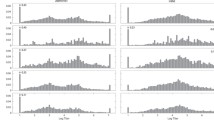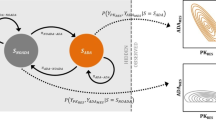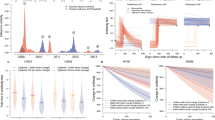Abstract
Patients that are exposed to biotechnology-derived therapeutics often develop antibodies to the therapeutic, the magnitude of which is assessed by measuring antibody titers. A statistical approach for analyzing antibody titer data conditional on seroconversion is presented. The proposed method is to first transform the antibody titer data based on a geometric series using a common ratio of 2 and a scale factor of 50 and then analyze the exponent using a zero-inflated or hurdle model assuming a Poisson or negative binomial distribution with random effects to account for patient heterogeneity. Patient specific covariates can be used to model the probability of developing an antibody response, i.e., seroconversion, as well as the magnitude of the antibody titer itself. The method was illustrated using antibody titer data from 87 male seroconverted Fabry patients receiving Fabrazyme®. Titers from five clinical trials were collected over 276 weeks of therapy with anti-Fabrazyme IgG titers ranging from 100 to 409,600 after exclusion of seronegative patients. The best model to explain seroconversion was a zero-inflated Poisson (ZIP) model where cumulative dose (under a constant dose regimen of dosing every 2 weeks) influenced the probability of seroconversion. There was an 80% chance of seroconversion when the cumulative dose reached 210 mg (90% confidence interval: 194–226 mg). No difference in antibody titers was noted between Japanese or Western patients. Once seroconverted, antibody titers did not remain constant but decreased in an exponential manner from an initial magnitude to a new lower steady-state value. The expected titer after the new steady-state titer had been achieved was 870 (90% CI: 630–1109). The half-life to the new steady-state value after seroconversion was 44 weeks (90% CI: 17–70 weeks). Time to seroconversion did not appear to be correlated with titer at the time of seroconversion. The method can be adequately used to model antibody titer data.








Similar content being viewed by others
Explore related subjects
Discover the latest articles and news from researchers in related subjects, suggested using machine learning.References
van Regenmortel MHV, Boven K, Bader F (2005) Immunogenicity of biopharmaceuticals: an example from erythropoetin. BioPharm Int 18:36–50
Schellekens H (2002) Bioequivalence and the immunogenicity of biopharmaceuticals. Nat Rev Drug Dis 1:457–462
Richards SM (2002) Immunologic considerations for enzyme replacement therapy in the treatment of lysosomal storage disorders. Clin Appl Immunol Rev 2:241–253
Cameron AC, Trivedi PK (1998) Regression analysis of count data. Cambridge University Press, Cambridge
Rose CE, Martin SW, Wannemuehler KA, Plikaytis BD (2006) On the use of zero-inflated and Hurdle models for modeling vaccine adverse event count data. J Biopharm Stat 16:463–481
Kianifard F, Gallo PP (1995) Poisson regression analysis in clinical research. J Biopharm Stat 5:115–129
Wilcox WR, Banikazemi M, Guffon N, Waldek S, Lee P, Linthorst GE, Desnick RJ, Germain DP, for the International Fabry Disease Study Group (2004) Long-term safety and efficacy of enzyme replacement therapy for Fabry disease. Am J Hum Genet 75:65–74
Corbiere F, Joly P (2007) A SAS macro for parametric and semiparametric mixture cure models. Comput Methods Programs Biomed 85:173–180
Acknowledgments
All authors are employees or past employees of Genzyme and hold stock in the company.
Author information
Authors and Affiliations
Corresponding author
Rights and permissions
About this article
Cite this article
Bonate, P.L., Sung, C., Welch, K. et al. Conditional modeling of antibody titers using a zero-inflated poisson random effects model: application to Fabrazyme® . J Pharmacokinet Pharmacodyn 36, 443–459 (2009). https://doi.org/10.1007/s10928-009-9132-x
Received:
Accepted:
Published:
Issue Date:
DOI: https://doi.org/10.1007/s10928-009-9132-x




